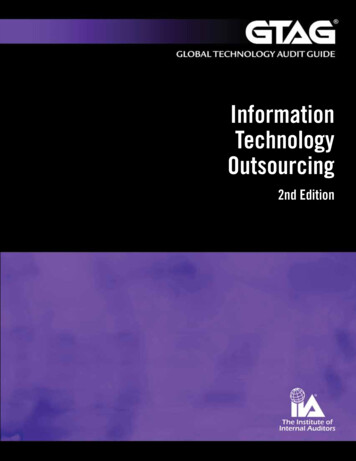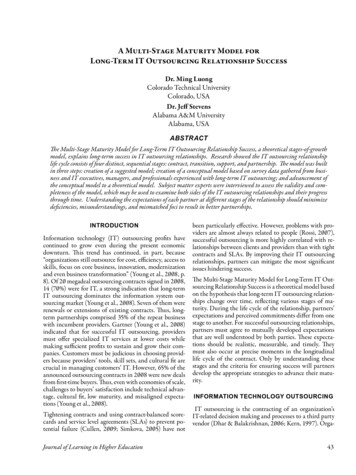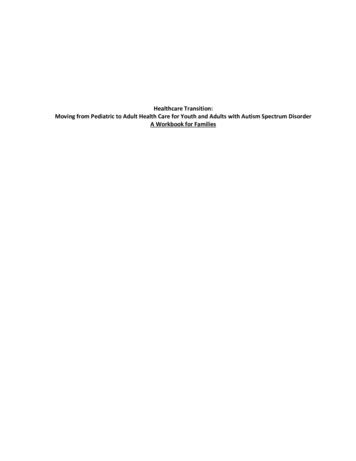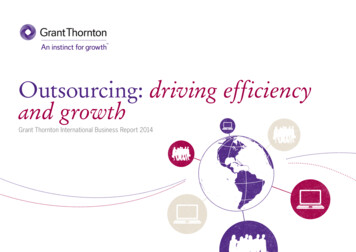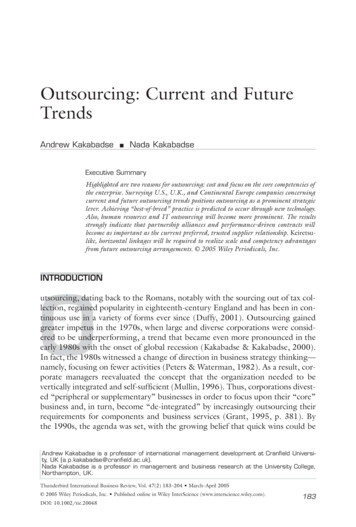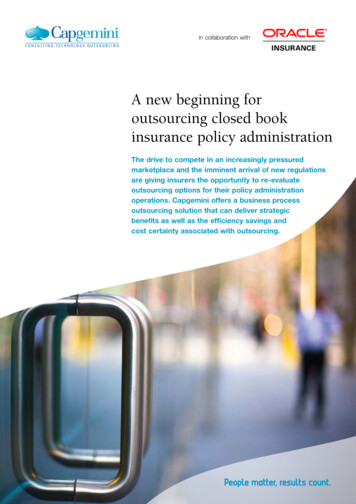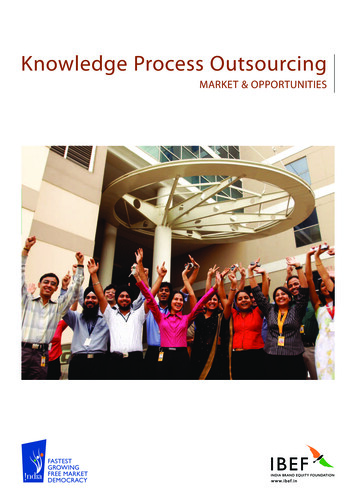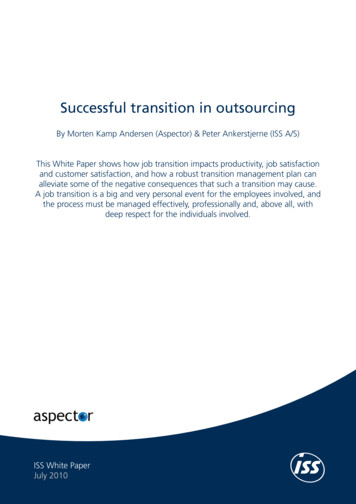
Transcription
Successful transition in outsourcingBy Morten Kamp Andersen (Aspector) & Peter Ankerstjerne (ISS A/S)This White Paper shows how job transition impacts productivity, job satisfactionand customer satisfaction, and how a robust transition management plan canalleviate some of the negative consequences that such a transition may cause.A job transition is a big and very personal event for the employees involved, andthe process must be managed effectively, professionally and, above all, withdeep respect for the individuals involved.ISS White PaperJuly 2010Proprietary information ISS A/S - Copyright 2010
Table of ContentsExecutive Summary1Introduction2The psychological effects of a job transition3Best practice in transition management in outsourcing7Conclusion16References17Proprietary information ISS A/S - Copyright 2010
Executive SummaryThis White Paper shows how job transition impacts productivity, job satisfaction andcustomer satisfaction, and how a robust transition management plan can alleviatesome of the negative consequences that such a transition may cause. A job transitionis a big and very personal event for the employees involved, and the process must bemanaged effectively, professionally and, above all, with great people skills.During job transitions employees go though four psychological phases that affecthow they feel and how they approach the outsourcing situation. And they go thoughthe phases at different speeds. Some will find themselves quickly embracing the newjob situation and see the road ahead as a positive challenge. Others will be stuck ina depressive and reactive mood and see the new conditions as a threat.All stakeholders (customer, employees and service provider) benefit from a worldclass transition management process. Good transition management will help theemployees pass safely and quickly through the four phases, whereas poor or nonexistent management will do the opposite. A successful transition process can takeproductivity and job satisfaction to a higher level than prior to the outsourcingprocess.Our research, which includes interviews with recently outsourced employees,concludes that there are 10 best practice activities that any robust transition planshould include. On the face of it, these 10 steps are easy to implement, but theyrequire a strong commitment from both the customer and the service provider aswell as a set of good transition management skills. The 10 best practice transitionactivities fall into four categories: project planning; communication; psychology (orpeople management); and job design.Proprietary information ISS A/S - Copyright 20101
IntroductionWork is an important part of our identity as human beings. Major changes to ourworking conditions are therefore a change to our self-understanding. Work is alsoa place where we look to fulfil some of our most fundamental needs such as theneeds for income, socialisation, recognition and more. It should not therefore comeas a surprise that any change in our work – or merely the suggestion of a change –will impact us in a significant way.Outsourcing is often associated with changes to several aspects of work. Firstly, it iscommon for the service provider to take on employees from the client. That meansthat many workers experience a change in employer, which in itself is a significantchange. A second change may be in the working conditions themselves. Examplesmay include pay and benefits, which might be changed, an increase in job scope, ornew ways of working.The process of transferring employees from one company to another duringoutsourcing is often referred to as a transition process. A transition process ultimatelyhas three goals. The first is to ensure a smooth transfer of responsibility so that theclient does not experience any disruptions to the service. The second is to handle thepeople side of the transition in such a way that the employees are treated fairly andwith respect. The third is to design the jobs to optimise working efficiency. Researchshows that most transitions fail to meet all three goals simultaneously.Change projects affect important psychological emotions in a negative way. Theseinclude anxiety, frustration, resistance, motivation, sense of well-being, and loyaltytowards the organisation. Research into transition management shows that theresults are similar in job transition situations.The many benefits of a successful transition are both tangible and financial benefitsfor the client as well as for the service provider. Research suggests higher jobsatisfaction, lower employee turnover and lower absenteeism as the most significantbenefits, but case studies also point to better customer service as a potential benefit.By building on the experience and knowledge of transition psychology and bestpractice from service providers and clients, we can understand and handle thenatural (and often predictable) reactions of employees.This White Paper will answer two key questions. Firstly, what reactions can we expectfrom employees during outsourcing? Secondly, what transition management stepscan ensure a successful outsourcing process?2Proprietary information ISS A/S - Copyright 2010
The psychological effects ofa job transitionTo understand the reactions of employees during a job transition and therebyplan a successful transition management programme, we need to understand thepsychological effects of such a change.There are two important things to know about transition management:During transitions people go though four phases that affect how they feel andhow they approach the outsourcing situation. And they go though these phases atdifferent speeds. Some will find themselves quickly embracing the new situation andsee the road ahead as a positive challenge. Others will be stuck in an introspectiveand reactive mood and see the new conditions as a threat.The reactions are 90% about the process and 10% about the change itself. At itscore transition management is about managing a change well. Research shows thatit is rarely the outsourcing itself that is the issue when things go wrong. Althoughmany employees have a negative association with outsourcing when first confrontedwith the term, however this rarely stands in the way of the process. The problemsare most often related to how the process is handled. This is down to leadership andtransition management from both the customer and the service provider.There are some common traps along the way in getting through the four phases. It isthe job of the transition team/manager to be aware of these traps so that the fasterand more skilfully the transition team/manager can navigate through the phases,and in so doing avoiding the traps, the better the overall transition will be.Figure 1: The transition phasesEngergy focusedoutwardsSShockEmbraceaceFocus on pastFocus on futureResistanceceTransformationTranEngergy focusedinwardsSource: AspectorProprietary information ISS A/S - Copyright 20103
Phase 1: Shock and disbeliefWhen an employee is faced with the news that his/her employer wants to outsource,the first reaction is usually shock, often followed by a sense of disbelief. How big theshock is depends on a number of variables such as whether the news was or couldhave been anticipated. If the company has already outsourced many other divisionsor if their financial results are quite poor, employees may anticipate the decision tooutsource. Other variables that affect the level of shock are the perception of theconsequences of outsourcing, attitude towards the service provider, the general jobmarket in the local area, how the news is delivered, the perceived job threat, andmany more.The long list of variables also explains why employees display such a range ofreactions to this initial news. Some are deeply shocked, visibly shaken by the news,and unable to work for the rest of the day or week, while others continue workingas if nothing has happened. Generally, however, managers tend to underestimatethe level of shock that employees experience.Phase 2: Resistance and frustrationOnce the initial shock fades, the employee will evaluate the situation and askthe question: “How will this affect me?”. Most employees will display some levelof resistance towards the outsourcing process. This is not because they are bademployees or because they will be in a worse situation than before. It is becausethis is a human reaction. We humans prefer status quo even if the promised futureis better than where we are right now. We tend to stick with what we know. Acommon reaction from managers is to use rational arguments and try to convinceemployees that things will be better. But this only works to a limited extent. Themanger must also deal with the emotional side because the real issue here is thatpeople are afraid.This fear will lead to resistance to change, which can take many different forms.The most visible is active and open resistance, where the employees may protestloudly at meetings or directly confront the manager or representatives of the serviceprovider.4Proprietary information ISS A/S - Copyright 2010
However, the transition manager must be aware that there are many other moresubtle forms of resistance. Examples include sabotage, forming coalitions, isolation,having little energy, not showing up for meetings, deliberately doing a bad job,talking badly of the outsourcing with the client, etc. This may also be a time whensome employees feel depressed and alone, and possibly take more sick-days.Table 1: Forms of resistance to changeOpenHiddenConsciousUnconsciousProtestOpen disagreementIsolationLIttle energyQuiet resistanceSabotageCoalitionsPsychological withdrawalMentally unable to changePhase 3: TransformationAt some point the employee will experience a transformation towards the changeinvolving a shift in perspective from looking at the past and wanting to stick withthe status quo to looking towards the future and the possibilities. This is principally acognitive and internal transformation where the employee discovers that “this maynot be such a bad thing after all”.The manager can support the employee in several ways during this phase. At this pointthe employee is more open to listening to some of the possibilities that the changemay bring. The manager can emphasise the general advantages of outsourcing suchas becoming part of a company whose core competencies are the same as theemployee’s, better training opportunities, better use of skills, personal developmentwithin the new organisation, etc. This may also be the best time to conduct a oneon-one meeting to discuss the design of the new job as well as listening to anyissues or suggestions that the employee may have regarding the future.Phase 4: Embrace and tryFinally, the employee will embrace the new situation with renewed energy anddesire. He/she will no longer mentally be stuck in the past, but instead see thepresent and the future as realistic and desirable. In practice, this means that theemployee no longer wishes that the outsourcing had never taken place or hopesthat the decision will be reversed.Proprietary information ISS A/S - Copyright 20105
The manager’s role during this stage must be a subtle one. This is not a good timefor micro-management and killing initiatives, but instead it is important to let theemployee use his/her energy to try out new things and see that the new environmentis bringing with it new opportunities. If the fragile hope of a better future is brutallymet by unnecessary micro-management, the employee is likely to go back one ortwo phases.The connection between transition stages and productivityThe transition process will impact productivity, job satisfaction and customersatisfaction. All three variables depend on how the employees feel about their work,and some level of disruption is inevitable.The connection between the four transition phases and productivity is illustratedin the figure below. The shock phase will bring some initial volatile change inproductivity as the employees get to grips with facts. During the resistance phase,productivity will be greatly impacted; how much will depend on the level of overallresistance and which employee groups display the resistance. The low point occursjust prior to the transformation, and once the employees embrace the new situation,productivity and job satisfaction will increase dramatically.Notice that a successful transition process can take productivity and job satisfactionto a higher level than prior to the outsourcing process.Figure 2: Transition phases and the impact on aceResistanceTransformationTimeSource: Aspector6Proprietary information ISS A/S - Copyright 2010
Best practice in transition managementin outsourcingWe have identified 10 best practice elements that will make a significant contributionto a successful transition. The 10 best practice elements will work across industriesand countries but need to be adjusted to the individual context. Our best practiceelements are based upon four sources: interviews with a number of ISS employeeswho had recently been through a transitions process; existing public case studies;existing research; and our own experience.The people we interviewed were from four different countries (Denmark, Finland,Singapore and Australia). They represented a broad range of different age groupsand job functions within the blue-collar facility management industry and werechosen randomly within randomly chosen contracts in pre-specified countries. Theinterviews, which lasted an average of 1 hour and 12 minutes, were all conductedwith people who has now been transferred to ISS.Interestingly, despite the fact that the interviewees spoke different languages, hadbeen through different transitions, worked in different types of organisation and haddifferent jobs, the interviews showed a remarkably high number of similarities. Thissuggests that many reactions to outsourcing come down to some basic human traits.The 10 best practice elements, which are listed in no particular order, are as follows:1. Follow a clear and robust transition processThe transition process must be planned well in advance of the opening initiatives.The transition phase itself – i.e. when the employees are notified and transferredfrom one employer to another – normally starts about three months prior to theofficial handover. Prior to the transition of employees, the customer organisation willhave worked through a planning phase . Michael Corbett (2004) suggests that thetimeline for preparing employees for change and assisting them through the processbegins about 12 months before the official handover and runs through to about 12months afterwards. This is illustrated in the figure below.Figure 3: Transition process-12 months-6 months-3 months03 months6 months12 monthsCustomerPrepare theorganisationfor changePrepare thepeople forchangeProviderTransition ofemployeesintegrateemployeesinto newcompanyEmployeegrowth anddevelopmentPhase 1: PlanningPhase 2: TransitionPhase 3: Integrations 0AY BENEFITS POLICIESs #OMMUNICATIONs %MPLOYMENT LAWs 4RANSITION PLANs 3EVERANCE PLANs !NNOUNCEMENTs %MPLOYMENT DECISIONs 4IMINGs 3UPPORTs )NVOLVEMENTs !SSOCIATIONs )NTEGRATIONs %VALUATIONs 4RAININGSource: Corbett, 2004Proprietary information ISS A/S - Copyright 20107
The entire process consists of several phases with many projects. Research showthat if this is not carefully planned in advance using a tested and robust transitionprocess such as the one outlined above, critical elements will not receive the properattention or will be completely overlooked.Our interviews identified several examples where the customer – especially the HRdepartment – lost all interest in the outsourced employees several months before theofficial handover. This left the employees in disarray, not knowing which organisationthey belonged to and feeling unwanted. An important point is that a successfultransition is the combined and successful effort of both the customer organisationand the service provider, and that only through a planned, aligned and combinedeffort will the transition be successful.2. The first meeting is very importantThe importance of the first meeting cannot and should not be underestimated. Thisis the meeting where the employees are told that their jobs will be outsourced. Asmentioned above, all employees are initially likely to experience shock and a feelingof disbelief. The first meeting is decisive for the level of shock that the employeeswill feel, and indeed how the transition process will succeed going forward.In many cases this meeting takes place before a vendor has been selected, andconsequently it is handled by the customer itself. In other cases the meeting is heldafter the provider has been selected. In one instance the customer decided to lettheir employees know by means of a letter, but not everybody received the letter andthe service provider ended up being the one to break the news. Unsurprisingly, thiswas not well received by the employees. Regardless of whether the first meeting isheld before a vendor has been selected or not, a few things are important regardingthe first meeting. Firstly, the CEO or another high-ranking representative of thecustomer should be present and explain the rationale for the outsourcing decision.This type of information must not come from middle management.A second point relates to the content of the meeting. At the first meeting, theemployees are only concerned about things that matter to them and their job. Forthem this is a very personal thing. They will therefore have question such as: Whatdoes this mean for me? Specifically, they often want answers to questions such as:Will I lose my job? Will I face a reduction in pay? Will I lose any of my benefits? WillI have to do a different type of job? Will I have to travel further to my workplace?The first meeting must address these questions.8Proprietary information ISS A/S - Copyright 2010
The meeting should be all about announcing the initiative, answering as many ofthe above questions as possible, and explaining the process ahead in simple terms.Details should be left for a follow-up meeting that can be held a few days later. Anin-depth introduction to the service provider – if one has been identified – shouldalso be left until later.3. Communicate, communicate, communicateIt is often said that there are three things that are important in a successful transition:communication, communication and communication. Our interviews suggest thatthis is indeed true. Communication was highlighted in all our interviews either asthe element that made the whole thing a success or the element that caused themost grief and upset.Three rules should be followed regarding communication; it must be honest, plentifuland meaningful (Corbett, 2004). Honest communication about the process andthe likely implications such as headcount reductions, changes in job content andalterations in pay and benefits is essential. Some managers cannot be honest withtheir employees because they do not know what is going to happen themselves. Ifthat is the case, the managers must communicate this to their employees becauseotherwise they will assume that their managers are withholding information fromthem. Likewise, giving false assurance is not a good idea.The communication must be plentiful. If the communication space is not filledwith deliberate, optimistic and honest communication from the leadership andmanagement team, then it will be filled by rumours, gossip and speculation from adisgruntled group of employees. People need to find meaning in their job, and theywill look for any explanation – even if it is both unlikely and negative. Rumours canimpact all levels of the organisation, causing fear and apprehension and leading tolower productivity and job satisfaction. Other functions that could be outsourced willstart to wonder if they are next, and rumours are likely to persist in those departmentsif communication is not addressed at them. The transition team must consider thefull range of communication channels: letters, e-mails, meetings, posters, companynewsletters, etc.Proprietary information ISS A/S - Copyright 20109
Finally, the communication must be meaningful and situation-relevant. Whenever theleadership and management team communicate something, it should be followedup with a “and here’s what we’re going to do about it”. During the initial phase,the employees are only interested in communication that relates to their specificpersonal situation. Issues relating to their department and company will be moremeaningful to them later on.It often comes as a surprise to managers that people do not hear what is beingcommunicated or hear different things. We interviewed people who had attendedthe same meeting but had heard and experienced different things. One said thatnothing was said and that the lack of information and ability to answer questionshad upset him, whereas another felt that the level of information was adequateand correct. This was because one could immediately see that the change had verylittle impact on his job, whereas the other was still looking for a clear answer tofundamental questions. Understanding what people are concerned about makes itpossible to understand whether they have heard the message or not.The communication coming from the customer and the service provider must bealigned. It is important to manage the communication between the two partiesbecause any differences will be interpreted with suspicion and anger. The responsibilityfor communication gradually shifts to the new employer after the initial meetingwhen the vendor has been announced, but employees will pay close attention tosubtle information from the customer until long after the official handover.4. The social aspect mattersThe outsourcing process has consequences beyond the actual job for most employees.Many of the people we have examined in our surveys and the case studies havepointed to social networks and benefits as important concerns during the transitionprocess. These concerns are related either to the loss of access to social settings inthe company or changes in their relationships with old colleagues.Many organisations offer benefits that also serve as opportunities for socialnetworking. Examples include a gym, arts club, travel club, etc. Other opportunitiesfor social networking within the customer organisation include the canteen,smoking areas and, importantly, the Christmas party. Once the department has beenoutsourced, it is common for the outsourced employees to no longer have access tothese opportunities and networks, and while many countries have employment lawsthat ensure monetary compensation for any loss of such benefits, the loss of socialnetworks can be significant and difficult to replace.10Proprietary information ISS A/S - Copyright 2010
Another aspect relates to the attitude towards the outsourced employees. Researchhas shown that once the outsourced employees become an external supportfunction, previous colleagues change their attitude towards them. There are manyreasons for this change: change of union membership, cutbacks in service levels aspart of savings, new uniforms, and different company image. Outsourced employeessay that the customer’s employees start to blame their department for things thatthey previously blamed on the customer’s leadership team.The transition team should consider how the social aspects can be best handled inadvance of the actual transition. It may be that the outsourced employees shouldbe allowed access to the gym and clubs following the handover. The transition teamcould also conduct a workshop where the outsourced employees are helped thoughthe expected changes in important social relationships.5. Identify key people and concentrate efforts on themIt is important to retain and keep most employees happy during the transitionprocess. A few, however, are crucial to the success of the entire project. As part ofthe planning stage, the transition team should therefore identify key people andconcentrate special efforts on making sure they are happy with the process.There are three types of key people that it is important to identify:1. People with important knowledge2. People with formal power3. People with informal powerThe number of key people that should be identified varies depending on the type ofcontract and the situation. A rule-of-thumb figure often given in research is 20%,but in site-specific, knowledge-heavy contexts the figure might exceed 50%.In some outsourcing situations the service delivery is based upon knowledge of thecustomer domain. This is particularly true for site-based services and, even moreso, services that are highly technical. In these situations the success of the entirecontract may depend on retaining a few key people.Proprietary information ISS A/S - Copyright 201011
The key people should be identified before the actual transition phase begins.However, it is common that some of the key people with informal power and/orheavy social influence can only be identified after the announcement has beenmade. In one of our interviews the transition manager gave us an example where aperson with social influence was identified though observing that many colleaguesspoke to him about their feelings on the outsourcing process and that he was able toreassure them. In this case, the person with informal power had a positive influenceon the process, but in many cases people with informal power may exert a negativeinfluence.6. Increase in job scope must be handled especially carefullyThe service provider will sometimes try to negotiate expansion of some of the jobroles so that the outsourced employees have to take on more tasks or work inteams. This is done in order to increase flexibility and cut costs.Research shows that multi-skilling – as this job expansion process is often referred to– is generally an effective way to design jobs in outsourcing as it improves flexibilityand quality of work as well as increasing job satisfaction through better use of skills,better training and higher job status. In other words, it has the potential to be ofbenefit to the service provider as well as the employee.All the people we interviewed were asked to take on new tasks as part of theoutsourcing process, which for the most part meant that they had to perform jobsthey had never done before. They all said that they were happy with this new jobrole now, but a few said that the process had been difficult. This supports researchon multi-skilling, which shows that it can significantly enhance productivity andjob satisfaction if handled well but, if not handled well, will actually lead to lowerproductivity and higher employee turnover. The transition team must consider priorto the transition phase which jobs will be expanded and subsequently design aprocess to implement this. Surveys show that a high degree of employee involvementin this process correlates with a high success rate.12Proprietary information ISS A/S - Copyright 2010
7. Bridge the culture gap between the employees and the service providerThe facility management division of the company is likely to have a significantlydifferent culture to the customer organisation. While the outsourced departmentmay not mirror the entire culture of the customer, evidence suggests that the overlapis significant.It has been documented over the years that a successful relationship betweenthe customer and the service provider hinges on how similar their cultures are. Ifthe culture gap is too wide, the service provider does not fit into the customer’senvironment and the customer cannot work with the service provider. Indeed,surveys in the US suggest that over 50% of firms believe that cultural fit is a keycriterion in the selection of vendors.The effect on employees during a transition between two companies has not receivedmuch attention in research and surveys. However, some evidence suggests that a‘culture shock’ can greatly affect the execution of the outsourcing contract. Theservice provider should therefore assess the culture of the outsourced department(s)and perform a cultural risk assessment. It may be that the transition period shouldbe extended if the culture gap is wide and shortened if it is narrow.Proprietary information ISS A/S - Copyright 201013
8. Overcome resistance as soon as it is observedResistance to change occurs in all transitions; how much and in what forms isdifferent from case to case. A robust and well-structured process will certainly limitthe resistance, but it will not entirely remove it.One thing, however, seems to be the case in all transitions; managers underestimatethe level and intensity of resistance. The primary reason for this is a lack of knowledgeof the different forms as highlighted above. Managers are simply not aware of theresistance because they think that unless it is visible and they are openly confronted,it is not present. This is a common mistake.Training of line managers in resistance management is therefore important. Managersmust be trained to be aware of the levels and forms of resistance, and also to dealwith conflicts and resistance. The majority of issues can – if discovered early – easilybe dealt with through honest and proper communication, most of which needs tobe done on a one-to-one basis.9. A dedicated transition team is an ideal solutionA transition team should be set up as early as possible in the process. The purposeof the team is to ensure that the people side of the contract is dealt with in aprofessional and proper manner. It is important that such a team is involved as earlyas possible.The transition team is responsible for designing a transition plan (such as theone outlined in item 1 above, but obviously in much more detail). During theentire transition process the team will coordinate with HR, finance, the internalcom
This White Paper shows how job transition impacts productivity, job satisfaction and customer satisfaction, and how a robust transition management plan can alleviate some of the negative consequences that such a transition may cause. A job transition is a big and very personal event for the employees involved, and the process must be
